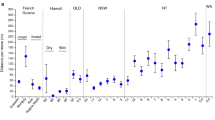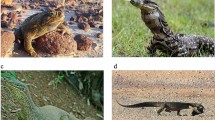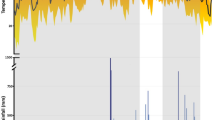Cane toads seem to have honed their dispersal ability to devastating effect over the generations.
Abstract
Cane toads (Bufo marinus) are large anurans (weighing up to 2 kg) that were introduced to Australia 70 years ago to control insect pests in sugar-cane fields. But the result has been disastrous because the toads are toxic and highly invasive. Here we show that the annual rate of progress of the toad invasion front has increased about fivefold since the toads first arrived; we find that toads with longer legs can not only move faster and are the first to arrive in new areas, but also that those at the front have longer legs than toads in older (long-established) populations. The disaster looks set to turn into an ecological nightmare because of the negative effects invasive species can have on native ecosystems1,2; over many generations, rates of invasion will be accelerated owing to rapid adaptive change in the invader3, with continual ‘spatial selection’ at the expanding front favouring traits that increase the toads' dispersal4,5.
This is a preview of subscription content, access via your institution
Access options
Subscribe to this journal
Receive 51 print issues and online access
$199.00 per year
only $3.90 per issue
Buy this article
- Purchase on SpringerLink
- Instant access to full article PDF
Prices may be subject to local taxes which are calculated during checkout

Similar content being viewed by others
References
Crossland, M. R. Ecography 23, 283–290 (2000).
Smith, K. G. Biol. Conserv. 123, 433–441 (2005).
Cox, G. W. Alien Species and Evolution (Island, Washington, 2004).
Simmons, A. D. & Thomas, C. D. Am. Nat. 164, 378–395 (2004).
Travis, J. M. J. & Dytham, C. Evol. Ecol. Res. 4, 1119–1129 (2002).
Lever, C. The Cane Toad. The History and Ecology of a Successful Colonist (Westbury, Otley, West Yorkshire, 2001).
Smith, M. A. & Green, D. M. Ecography 28, 110–128 (2005).
Choi, I., Shim, J. H. & Ricklefs, R. E. J. Exp. Zool. 299A, 99–102 (2003).
Freeland, W. J. & Martin, K. C. Aust. Wildl. Res. 12, 555–559 (1985).
Thomas, C. D. et al. Nature 411, 577–581 (2001).
Author information
Authors and Affiliations
Corresponding author
Ethics declarations
Competing interests
The authors declare no competing financial interests.
Supplementary information
Supplementary information
(PDF 169 kb)
Rights and permissions
About this article
Cite this article
Phillips, B., Brown, G., Webb, J. et al. Invasion and the evolution of speed in toads. Nature 439, 803 (2006). https://doi.org/10.1038/439803a
Received:
Accepted:
Published:
Issue date:
DOI: https://doi.org/10.1038/439803a
This article is cited by
-
Large-landscape connectivity models for pond-dwelling species: methods and application to two invasive amphibians of global concern
Landscape Ecology (2024)
-
Analysis of Morphological Change during a Co-invading Assemblage of Lizards in the Hawaiian Islands
Evolutionary Biology (2024)
-
How mutation shapes the rate of population spread in the presence of a mate-finding Allee effect
Theoretical Ecology (2023)
-
River bank burrowing is innate in native and invasive signal crayfish (Pacifastacus leniusculus) and is driven by biotic and abiotic cues
Biological Invasions (2023)
-
Body-size dependent foraging strategies in the Christmas Island flying-fox: implications for seed and pollen dispersal within a threatened island ecosystem
Movement Ecology (2022)



